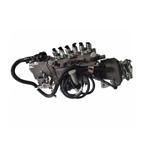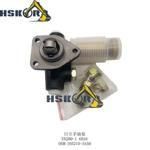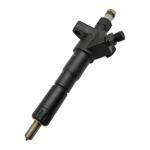Information injection-pump assembly
BOSCH
9 400 613 184
9400613184
ZEXEL
101608-6351
1016086351
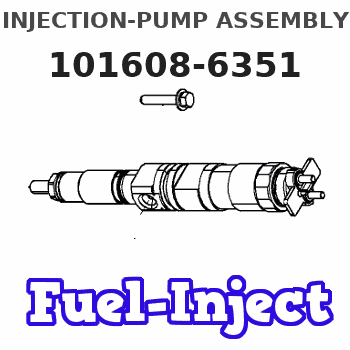
Rating:
Service parts 101608-6351 INJECTION-PUMP ASSEMBLY:
1.
_
7.
COUPLING PLATE
8.
_
9.
_
11.
Nozzle and Holder
ME440071
12.
Open Pre:MPa(Kqf/cm2)
17.7{180}
15.
NOZZLE SET
Include in #1:
101608-6351
as INJECTION-PUMP ASSEMBLY
Include in #2:
104749-0443
as _
Cross reference number
BOSCH
9 400 613 184
9400613184
ZEXEL
101608-6351
1016086351
Zexel num
Bosch num
Firm num
Name
Calibration Data:
Adjustment conditions
Test oil
1404 Test oil ISO4113 or {SAEJ967d}
1404 Test oil ISO4113 or {SAEJ967d}
Test oil temperature
degC
40
40
45
Nozzle and nozzle holder
105780-8140
Bosch type code
EF8511/9A
Nozzle
105780-0000
Bosch type code
DN12SD12T
Nozzle holder
105780-2080
Bosch type code
EF8511/9
Opening pressure
MPa
17.2
Opening pressure
kgf/cm2
175
Injection pipe
Outer diameter - inner diameter - length (mm) mm 6-2-600
Outer diameter - inner diameter - length (mm) mm 6-2-600
Overflow valve
131424-5520
Overflow valve opening pressure
kPa
255
221
289
Overflow valve opening pressure
kgf/cm2
2.6
2.25
2.95
Tester oil delivery pressure
kPa
255
255
255
Tester oil delivery pressure
kgf/cm2
2.6
2.6
2.6
RED4 control unit part number
407915-0
590
RED4 rack sensor specifications
mm
19
Direction of rotation (viewed from drive side)
Left L
Left L
Injection timing adjustment
Direction of rotation (viewed from drive side)
Left L
Left L
Injection order
1-5-3-6-
2-4
Pre-stroke
mm
4.2
4.15
4.25
Beginning of injection position
Governor side NO.1
Governor side NO.1
Difference between angles 1
Cal 1-5 deg. 60 59.5 60.5
Cal 1-5 deg. 60 59.5 60.5
Difference between angles 2
Cal 1-3 deg. 120 119.5 120.5
Cal 1-3 deg. 120 119.5 120.5
Difference between angles 3
Cal 1-6 deg. 180 179.5 180.5
Cal 1-6 deg. 180 179.5 180.5
Difference between angles 4
Cyl.1-2 deg. 240 239.5 240.5
Cyl.1-2 deg. 240 239.5 240.5
Difference between angles 5
Cal 1-4 deg. 300 299.5 300.5
Cal 1-4 deg. 300 299.5 300.5
Injection quantity adjustment
Rack position
(11.1)
PWM
%
50.4
Pump speed
r/min
900
900
900
Average injection quantity
mm3/st.
124.5
123.5
125.5
Max. variation between cylinders
%
0
-2.5
2.5
Basic
*
Injection quantity adjustment_02
Rack position
(7.3)
PWM
%
29.4+-2.
8
Pump speed
r/min
425
425
425
Average injection quantity
mm3/st.
11
9.5
12.5
Max. variation between cylinders
%
0
-15
15
Governor adjustment
Pump speed
r/min
600
Advance angle
deg.
3
2.5
3.5
Load
0/4
Remarks
Start
Start
Governor adjustment_02
Pump speed
r/min
-
Advance angle
deg.
0
0
0
Load
0/4
Remarks
Measure the actual speed.
Measure the actual speed.
Governor adjustment_03
Pump speed
r/min
850
Advance angle
deg.
0.5
Load
4/4
Governor adjustment_04
Pump speed
r/min
1025
Advance angle
deg.
1.5
1
2
Load
4/4
Remarks
Finish
Finish
Test data Ex:
Speed control lever angle
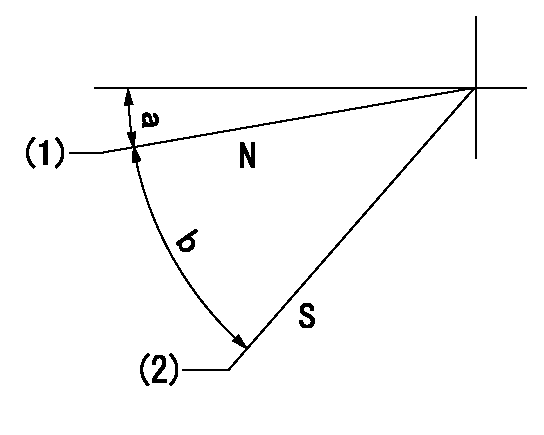
N:Pump normal
S:Stop the pump.
(1)Rack position = aa
(2)Rack position bb
----------
aa=20mm bb=1mm
----------
a=5deg+-5deg b=37deg+-5deg
----------
aa=20mm bb=1mm
----------
a=5deg+-5deg b=37deg+-5deg
0000000901

(1)Pump vertical direction
(2)Coupling's key groove position at No 1 cylinder's beginning of injection
(3)B.T.D.C.: aa
(4)-
----------
aa=8deg
----------
a=(0deg)
----------
aa=8deg
----------
a=(0deg)
Stop lever angle

(PWM) Pulse width modulation (%)
(R) Rack position (mm)
Rack sensor output characteristics
1. Rack limit adjustment
(1)Measure the rack position R2 for PWM a2%.
(2)Confirm that it is within the range R2 = 15+-1 mm.
(3)Measure the rack position R1 at PWM a %.
(4)Confirm that it is within the range R2 - R1 = 10+-0.1 mm.
2. Check the limp home operation.
(1)Move the switch box's limp home switch to the limp home side.
(2)Confirm rack position L1 (mm ) and L2 (mm) for PWM in the above table.
3. Check the pull down operation.
(1)Confirm that the rack position is 19 mm at PWM B%.
(2)In the conditions described in the above table, move the switch box's pull down switch to the pull down side and confirm that the rack position momentarily becomes 1 mm or less.
----------
a1=16.25% a2=72.5% L1=1--mm L2=19++mm A=5% B=95%
----------
----------
a1=16.25% a2=72.5% L1=1--mm L2=19++mm A=5% B=95%
----------
Information:
Fan Belt
Removal
Fig. 1-Cap Screw and BoltLoosen cap screw and alternator mounting bolt (Fig. 1). Move alternator so fan belt can be moved off pulley. Remove fan belt.Repair
Inspect belts for:1 Cracking2 Rupture3 Tears4 Burning5 Gouging6 Wear7 Internal Cord Failure8 Cuts9 Peeling, Fraying, ChewingDo not reuse a damaged belt. Install a new belt.Installation
Fig. 2-Install Fan BeltPut fan belt over fan (1, Fig. 2). Put fan belt over crankshaft pulley (2) and alternator pulley (3). Position fan belt in pulley grooves.Adjust fan belt tension (Group 9010).Crankshaft Pulley
Removal
Remove fan belt from pulley (Group 0429).
Fig. 3-Cap Screw and WasherRemove cap screw and washer (Fig. 3) holding crankshaft pulley on crankshaft. IMPORTANT: On six cylinder engines the crankshaft pulley is also a vibration damper. Do not drop or hammer on vibration dampers.
Fig. 4-D01200AA PullerUsing D01200AA Puller (Fig. 4), pull crankshaft pulley off crankshaft.Repair
Inspect pulley sheaves for cracks and wear. Replace pulley if damaged.For vibration damper repair, see Group 0401.Installation
Position crankshaft pulley on crankshaft.Put washer on cap screw. Install cap screw through crankshaft pulley into crankshaft.
Fig. 5-Cap ScrewTighten cap screw (Fig. 5) to 85 lb-ft (115 N m) (12 kg-m).Install fan belts (Group 0429).Adjust fan belt tension (Group 9010).
Removal
Fig. 1-Cap Screw and BoltLoosen cap screw and alternator mounting bolt (Fig. 1). Move alternator so fan belt can be moved off pulley. Remove fan belt.Repair
Inspect belts for:1 Cracking2 Rupture3 Tears4 Burning5 Gouging6 Wear7 Internal Cord Failure8 Cuts9 Peeling, Fraying, ChewingDo not reuse a damaged belt. Install a new belt.Installation
Fig. 2-Install Fan BeltPut fan belt over fan (1, Fig. 2). Put fan belt over crankshaft pulley (2) and alternator pulley (3). Position fan belt in pulley grooves.Adjust fan belt tension (Group 9010).Crankshaft Pulley
Removal
Remove fan belt from pulley (Group 0429).
Fig. 3-Cap Screw and WasherRemove cap screw and washer (Fig. 3) holding crankshaft pulley on crankshaft. IMPORTANT: On six cylinder engines the crankshaft pulley is also a vibration damper. Do not drop or hammer on vibration dampers.
Fig. 4-D01200AA PullerUsing D01200AA Puller (Fig. 4), pull crankshaft pulley off crankshaft.Repair
Inspect pulley sheaves for cracks and wear. Replace pulley if damaged.For vibration damper repair, see Group 0401.Installation
Position crankshaft pulley on crankshaft.Put washer on cap screw. Install cap screw through crankshaft pulley into crankshaft.
Fig. 5-Cap ScrewTighten cap screw (Fig. 5) to 85 lb-ft (115 N m) (12 kg-m).Install fan belts (Group 0429).Adjust fan belt tension (Group 9010).
